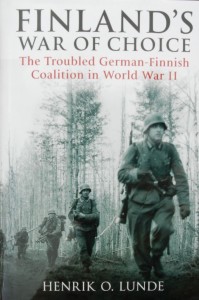While there are many books on the Russo-Finnish Winter War of 1939-1940, there are very few available in English that cover the 2nd war that Finland fought against the USSR, the “Continuation War” of 1941-1944. While not neglected in Finnish-language studies, there is a dearth of historical works in English on this little-known World War 2 front that, in studies of the Eastern Front, is usually glanced over without any detailed examination. “Finland’s War of Choice” by Henrik Lunde is the first in English to make a serious attempt to address this deficiency and is a welcome examination of a sadly neglected episode in the history of World War 2.
Lunde’s book sets out to describe the coalition (it was never a formal alliance) between Germany and Finland in the latter years of WW2. The prologue of this book briefly examines the history of Finland, from its separation from the Soviet Union in 1917 to its isolation after the Winter War of 1939-40. It then examines both Finnish and German motives for forming a coalition against the USSR and the war that followed. Lunde himself describes the historiographical focus of the book as primarily addressing “the unique problems that arose from an ill-prepared coalition between a democracy and a dictatorship”.

Finland’s War of Choice by Henrik O. Lunde
The book itself starts out by briefly covering Finnish history after independence from Russia (gained at the time of the Bolshevik Revolution) and through the 1920’s and 1930’s. The 1939-1940 Winter War where the USSR attacked Finland is then looked at, together with the ramifications for Finland including the territorial losses (around 10% of Finland, including the strategic Karelian Isthmus – still occupied by Russia) and the severe economic and strategic impact. The book describes how, after the Winter War, Finland was in an invidious position. The British and French had not provided any assistance in the Winter War, while the Germans, whom the Finns had looked upon as a balance to the USSR, were as a result of the Molotov-Ribbentrop Pact, at least nominally allied with the USSR and could not be expected to offer any assistance. Post-Winter War, the USSR continued to exert pressure on Finland and appeared to want a second war to subdue Finland in its entirety. However, German-Soviet relations were slowly souring, and Germany began planning a surprise attack on the Soviets. Finland could either stand aside, and perhaps be devoured by the Soviets, or ally with the Germans against the Soviets. As the book details, the Finns bet on the Germans.
Lunde sets out the decisions made by Finland’s civil and military leadership as it fended off the Soviets and aligned with Germany. Finland was the only democratic state that aligned itself with the Nazis and though this was perhaps “the least harmful choice among bad alternatives”, Lunde does not explore the human aspect of these critical decisions and the diplomatic moves which led to the coalition are not covered in any detail. We get a sense that this coalition between democracy and dictatorship was one of mutual convenience but the personal Finnish element and the Finnish background to the decision is woefully missing. This is one of the major shortfalls of “Finland’s War of Choice”.
As it was, the relationship between the Germans and Finns was not a true alliance, it was more a case of “co-belligerents”. The Germans, probably because they anticipated knocking the Soviets out of the war quickly, did not have a coherent plan for the Finnish Front, nor did they and the Finns come to agreement on specific objectives before the Germans invaded the Soviet Union. As the war progressed and then deteriorated (from the German/Finnish point of view), the divergence in each country’s goals and concerns led to the Germans basically wasting a strong Army in Finland, remaining in place and doing little or nothing for most of the war.
Lunde is perhaps most successful in the straightforward telling of the military operations of the Continuation War, both on the strategic and tactical level, although even here there is far more emphasis on German operations rather than Finnish. Among the more interesting sections of the book is chapter four which describes the numerous attempts to cut the Murmansk rail line from central Finland and thus cut off Murmansk itself – the main port for Lend-Lease shipments from the UK and the USA which were critical to the Soviet war effort. The next chapter, describing the primarily Finnish offensives in Ladoga Karelia and the Karelian Isthmus are equally enthralling, particularly as it will likely be the first time many non-Finnish readers have ever seen descriptions of the offensives in print.
Unfortunately however Lunde’s “Finland’s War of Choice” suffers from the same problem that many books on Finland written by non-Finns suffer from – the author’s lack of any knowledge of the Finnish language and consequent lack of use of primary or even secondary Finnish-language source material. Lunde states this himself in the prologue, saying that “My own difficulty in reading Finnish has served as a limitation on the use of Finnish sources….”, and likewise admits his inability to read Russian sources. This is unfortunate as it has meant that recent Finnish research and publications on the Continuation War, as well as primary source material, have been missed by the author. Recently available Russian-language source material has likewise been omitted – the author states that “My use of Russian sources has basically been limited to works that have been translated to English.” (I should point out however that the author does read Swedish).
In point of fact, Lunde relies heavily on German sources, primarily General Waldemar Erfurth’s “Der Finnishe Krieg 1941-1944” (1950) and “The Last Finnish War” (1979), Earl Ziemke’s “The German Northern Theatre of Operations 1940-1945” (1959) and to a lesser extent on Finnish books which have been translated into English – Olli Vehvilainen’s “Finland in the Second World War. Between Germany and Russia” (2002) and “The Memoirs of Marshal Mannerheim” . Lunde’s chapter endnotes show heavy use of these sources throughout the book. The Memoirs of Marshal Mannerheim seem to be one of the two main Finnish sources cited – and the problem with using Mannerheim as a source (a problem not mentioned in the book) is that his memoirs were written and published at a time when Finland was in a precarious geo-political position during the immediate post-war years. The Soviet “Peace Commission” in Helsinki ruled the roost and a something as insignificant as a misplaced word words could send still another Finnish leader or officer to prison on trumped up charges, as happened to all too many Finns in the immediate post-war years. In point of fact, until the unlamented demise of the USSR, no Finnish leader could be totally candid when it came to anything to do with the Soviet Union, and particularly when it came to any mention of WW2. Indeed, this is still an area where Finnish politicians and leaders tread lightly.
As a result, Lunde does not cover internal affairs within Finland in any detail (political debates over the war and the stress of the war on Finland’s economy are hinted at, but never described) and the descriptions of the Finnish Army’s operations campaigns are much less detailed than those of the German’s. Lunde also has a somewhat superficial understanding of Finland’s strategic position – something which the title of the book reflects – “Finland’s War of Choice.” “Choice” is not really a word one would apply to the invidious position Finland found itself in in the aftermath of the Winter War. Lunde skims over the surface in looking for evidence of some culpability with regard to Finland’s participation in its second war with the Soviet Union. It is easy to criticise the thinking of Finland’s leaders in entering into a 2nd war with the USSR as a co-belligerent with Germany. However, one must keep in mind that Finland had no good options available – Finland had lost one war with the USSR with consequent large territorial losses, the USSR had annexed the three small Baltic States and post-Winter War, continued to apply pressure on Finland. Assistance from Britain would not be forthcoming, France had fallen and the USA was maintaining a determined neutrality.
Finland in 1940-1941 was indeed in an invidious position, caught between Stalin on the one hand and Germany on the other. That Finland chose a co-belligerency agreement with Germany was the best of the bad positions available to Finland and Lunde could perhaps have done a better job of examining this aspect of the war within the context of this period of WW2 and Finland’s strategic situation. What is perhaps most telling is that through WW2, the United States did not declare war on Finland even when the USA entered the war against Germany. Washington at least understood the Finnish dilemma. And Finland, for their own reasons, never acquiesced to the German plans, refusing to cut the Murmansk Railway (something they could easily have done) and refusing to join in the siege of Leningrad. While Lunde delves into this area, his focus is more on the military operations – he could have done a better job of capturing the broader picture and the internal Finnish debates behind it. The book ends with a solid and fairly detailed account of the Soviet campaign against Finland in mid-1944 and the subsequent LaplandWar between German and Finnish forces.
Even with its limitations however, this book is valuable for English readers wanting to learn more about Finland and her embroilment with Germany and the USSR between 1941 and 1944. It’s the only readily available and recent study of the Continuation War in English. It gives the reader a solid chronological description of the war and provides a somewhat superficial understanding of Finland’s strategic position and thinking before, during, and after the war (anyone interested in how Finland became a co-belligerent with Germany in 1940-1941 period should read Anthony Upton’s 1964 book “Finland in Crisis 1940-1941”. Unlike Lunde, Upton is able to read and cite Finnish, in addition to German, sources). Flaws and weaknesses aside, Lunde does outline and analyze the coalition between Germany and Finland and it’s aftermath.

Col. Henrik O. Lunde
The strength of Lunde’s book is that it provides a good detailed operational history of Finland’s Continuation War, with good coverage of the fighting against the USSR from 1941 through to 1944, followed by the brief Lapland War between Germany and Finland in 1944. The book captures the size and scope of the operations and fighting (I still find it astounding that a country with a population of a mere 3.7 million managed to field an Army of 500,000 men). As the first book in English that covers the Continuation War in detail, it certainly provides a good detailed introduction, albeit with some flaws.
Overall, Finland’s War of Choice is a solid and readable work that’s worth a place on your bookshelf.
The author, Henrik Lunde, is a native Norwegian and a retired US Army Special Operations Colonel who has written three books on various aspects of World War 2, all of them very readable. These books are “Finland’s War of Choice: The Troubled German-Finnish Alliance in World War 2″, Hitler’s Pre-Emptive War: The Battle for Norway 1940” and most recently, “Hitler’s Wave Breaker Concept: An Analysi of the German End Game in the Baltic.”
 Copyright secured by Digiprove © 2013 Alternative Finland
Copyright secured by Digiprove © 2013 Alternative Finland


